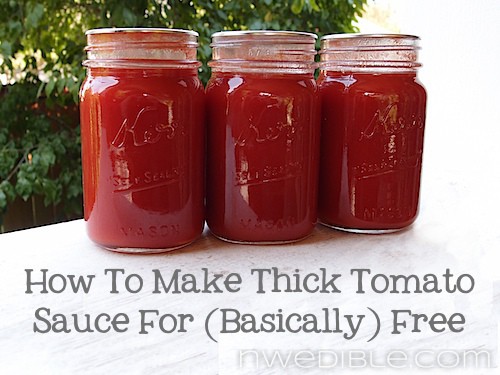
It has come to my attention that many people are unwittingly throwing away free tomato sauce when they preserve their summer tomatoes.
Here’s the thing: like all fruit, the skin of tomato is where much of the natural pectin resides. Pectin is the starch that gives jams their thickness and good tomato sauce its natural, noodle-coating thickness.
But tomato skins in a canned tomato product can be tough and stringy, and do that thing where they stick between your teeth and make you feel like you are getting a floss job from Satan’s dentist. This is why almost every canned tomato recipe calls for the initial step of coring, blanching and skinning tomatoes.
When you are working with 50 or 150 pounds of tomatoes at a time, those cores and skins really add up. If you are just chucking them to the chickens you are missing the opportunity to make really excellent – and essentially free – thick, smooth tomato sauce.
The Secret Ingredient is “Free”
Here’s what you do to turn all those “waste”skins into top-quality, pectin-rich, thick tomato sauce.
Sort tomatoes. Any that are showing signs of rot, mold or disease just chuck.
Wash all your perfect canning tomatoes. I wash my tomatoes in my previously-sanitized sink and add a small splash of bleach to the water. I do this because I will be saucing the skins and I want to cut down on any contaminants on them, but you can decide for yourself if you want to take this step, or perhaps substitute a good quantity of vinegar for the bleach. Because my tomatoes are locally hand-harvested they tend to be pretty clean, but I keep an eye out for any patches of dirt or pieces of tomato leaf and gently scrub these areas clean if necessary.
Rinse, dry and core tomatoes. Save those cores.
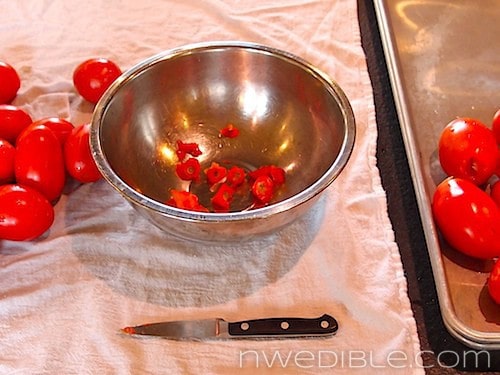
Because I’m right-handed, whenever possible I move from left-to-right when preparing produce for processing. I find this to be most efficient.
Blanch and slip the skins of the tomatoes. Save those skins.
Proceed to do whatever you were going to do anyway with all your peeled tomatoes. Save any extra juice or seeds from additional prep of the tomatoes.
Put all the clean cores, skins, juice and seeds you set aside in a big pot and start simmering. You can’t overcook this, but you can scorch it, so keep the heat on medium and give it a good stir every few minutes.
When everything in the pot is falling-apart tender, say after an hour or more of cooking, and you have a good break where you can attend to your sauce (the 85 minutes while whole peeled tomatoes process in a boiling water bath is an excellent time), puree the contents of the pot. The absolute easiest way to do this is with an immersion blender.
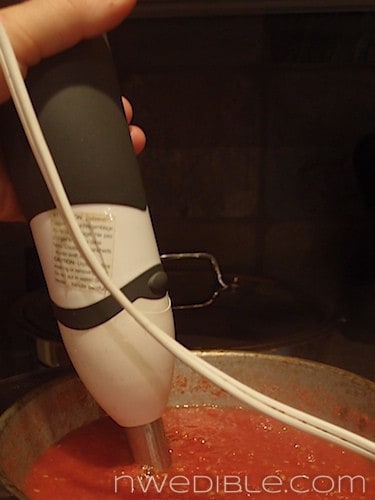
An immersion blender is the simplest, safest way to turn something hot and chunky into something hot and smooth.
Alternatively, you can let the mixture cool a bit and puree it in batches in a blender or food processor. Just a warning: hot liquids + blender = tomato sauce on the ceiling and scalded cook if you aren’t careful. Do a Google search on how to blend hot liquids before you go this route. (After which you will probably decide to take my advice and just go buy an immersion blender.)
When your sauce is smooth-ish, work it through a fine-mesh strainer or chinoise. Use a small ladle or spatula to push all the thick pulp through the strainer while leaving the now straw-like skins behind. Really go for it at this point – you don’t want to leave anything but dry skins and seeds in that strainer.
I strain my sauce directly into a second, clean stockpot. If all my large pots are in use, I strain into a large bowl, clean the original stockpot of any stuck-on tomato peels, and pour the finished stock back in.
Return your sauce to the heat and reduce until it is at your desired consistency. Season to taste with salt and, if desired, proceed to preserve by canning or freezing.
Remember, tomato sauce requires the addition of 1 tbsp of bottled lemon juice or ½ tsp citric acid per pint to be safely water bath canned. Here’s info on safe acidification practices for tomato products. Pints require 35 minutes of processing in a boiling water bath at sea level. Here’s additional information on safe ways to process tomato sauce.
Is It Worth It?
If you’ve never done this, you will probably be surprised at how much sauce you get from what you would have normally just thrown away.
These are the sauce yields from three separate tomato-processing events this summer:
Batch one: 150 pound of Roma tomatoes yielded 17 pints of thick, skin-based tomato sauce
Batch two: 40 pounds of Romas yielded 5 pints of thick, skin-based tomato sauce
Batch three: 50 pounds of Romas yielded 9 pints of thick, skin-based tomato sauce
So, depending on how much flesh clings to the skin of your tomatoes when you peel them and how much you reduce your stock, I’d estimate you will get 1 pint of finished sauce for every 6 to 9 pounds of canning tomatoes you peel and core.
This is a great way to eek as much possible goodness out of your harvest or hard-purchased tomatoes. From 90 total pounds of raw canning tomatoes, using this method to recapture sauce from the skins led to a total amount of composted waste of less than 3-and-a-quarter pounds. That’s a processing loss rate of about 3.5% which is, in my opinion, excellent.
If you are canning 50 pounds of tomatoes or more, you will definitely have enough skins to make this process worthwhile. If you work in smaller batches, you might consider saving all your cores and peels in the freezer until you have accumulated enough to make this food reclamation process make sense. The freezing of the peels will not noticeably impact the final texture of the sauce.
Free tomato sauce! And you don’t even have to dumpster dive to get it.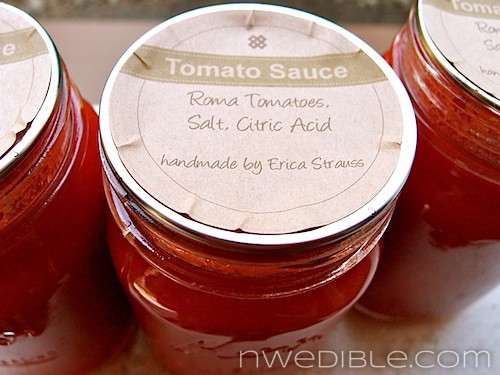
Not-Free Stuff That Helps A Lot When You Are Making Free Tomato Sauce:
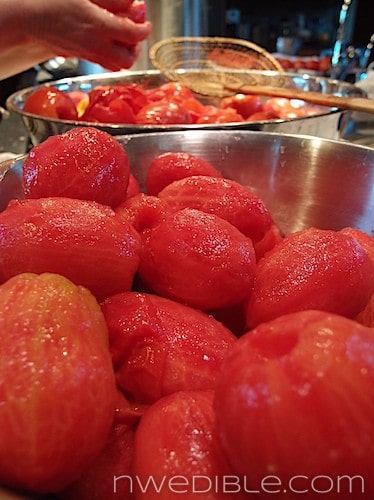


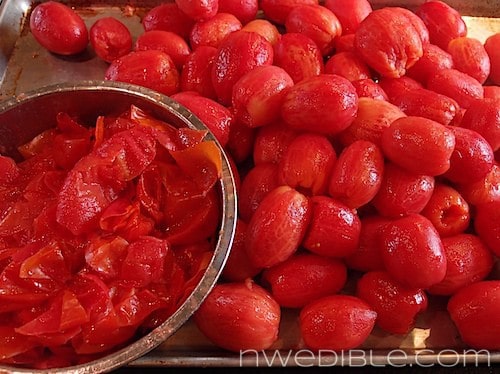
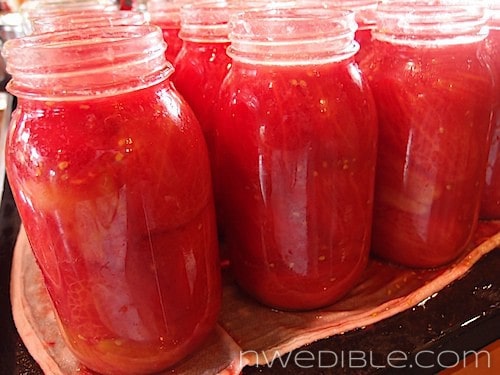
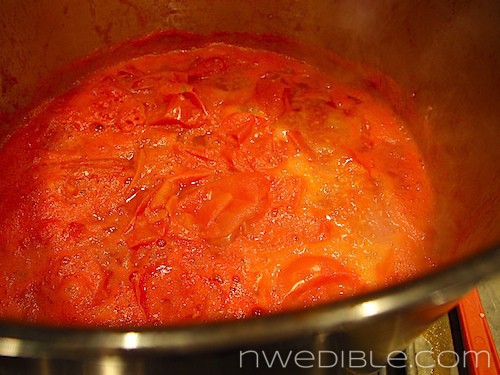
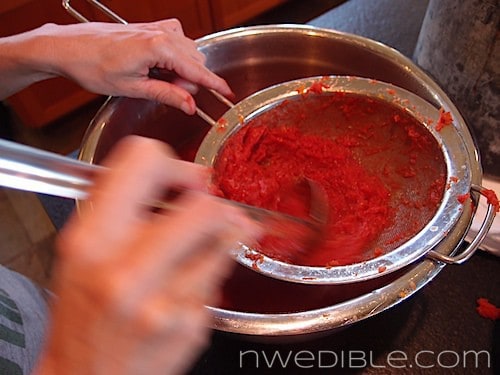
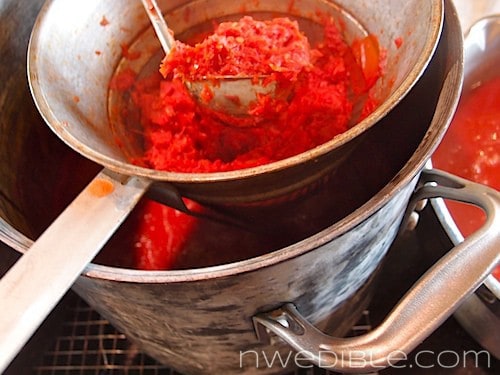

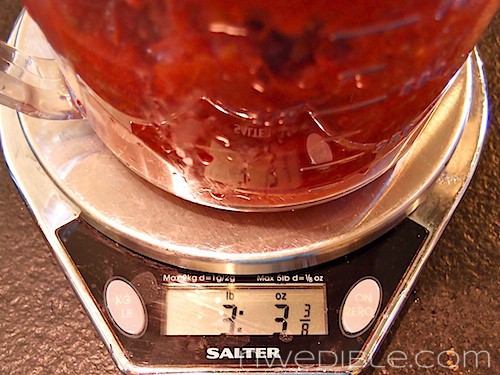



Thank you for this!! I saw this article the other day on Facebook (actually, someone had copied YOUR entire article and posted it under their page but luckily someone noticed and referred your website, I tried to look for that original post but I don’t remember who did it and I think they deleted it because I checked every site that I could have thought of that might have posted it and it’s nowhere to be found. The audacidy of some people I tell ya, like no one would notice!). Anyway, yesterday I bought 30 lbs of tomatoes from a farmer, used 20 lbs for sauce last night and saved all the cores and pulp in the freezer, tonight with the last 10 lbs and 1 lb of roma tomatoes from my own garden I am going to can up the rest as salsa and some whole and with all the leftover goodies I am going to do this!! I can’t wait! 😀
Freezing vs canning…
If freezing, is the citric acid necessary?
Great description of the whole process, by the way.
Tried this tonight, from skins frozen from two batches of tomatoes. I’m amazed, not only by the quantity, but the quality–so lovely and thick compared to sauce from whole tomatoes. I’m a believer!
It has taken me about 12 days to get through my canning. I have been saving my scraps and adding to it with each canning effort. I kept them in the fridge the whole time. Is that OK or do you think that the scraps from my first batch may have gone bad from being in the fridge for almost 2 weeks? thanks
My first year as a tenant gardener, and as I don’t care for fresh tomatoes, but love sauce and sauce-based foods, I kind of made up my own “garden sauce” recipe. I use all different kinds of tomatoes, plus eggplants, summer squash, zucchini, onions, peppers and whatever else is ripe or tempting. I wash and throw it all into a counter top roaster and slow cook it overnight, or all day (sometimes both depending on my schedule), let cool and push it through a large colander. After it has cooled, it can be stored in the fridge before pressing. I don’t have a food mill yet, so I press with a large ladle and my hands leaving just the dry vegetable skins and squash seeds. Depending on balance of ingredients, I sometimes add some organic tomato paste to thicken it, or leave it thinner for use as soup stock, juicing, etc. I freeze the sauce in quart bags and it is delicious. Each bag can then be used as a base later, adding seasonings according to your recipes.
Thank you so much for this useful information. I just knew there is a way to make use of the tomato skins!!! I am cooking mine down with Anaheim peppers from my garden, garlic, dried garlic chives from the garden, and some powdered onion since I was out of fresh onions. I am cooking this on low in my crockpot tonight. We’ll see what happens!
I am in LOVE with this website… directions are sooo much more clear with the pictures. One question… would you always elect to have a smoother sauce? I personally always go with a little bit lumpier sauce… just a thought
I am curious as to why someone would cook whole skinned tomatoes in a bath of water for 85 mins? Water *never* goes in my home made tomato sauce when using my garden tomatoes! What is the purpose??
I wouldn’t know. I raw pack my tomatoes in their own juice, and without added liquid.
I usually dehydrate my skins and then when they are nice and dry, I blenderize them into a powder. I can then use them to add back into my sauces to make it thicker or add to other dishes. Also makes for great dehydrated meals on the go also.
i don’t can tomatoes and do all that processing, i just pop them in the freezer whole once frozen food saver them. you can use them for anything and the skins peel right off by quickly running under water. you can chop them frozen etc.
this saves on time, jars – save for jam and meat, and sanity. have fun.
couldn’t you also dehydrate the strained skins and seeds and crush into a powder after making the sauce? even less waste 🙂 none!
couldn’t you dehydrate the skins and seeds that have been strained to make powder? then there would be no waste 🙂
Sounds like a great idea!!!
Yup! I did this about two years ago. I dehydrated the solids into small pucks. When I need some powder, I use a puck or break off a chunk of a puck & pulverize. I’m still using them now, as it took me awhile to figure out when & where I needed tomato powder, but it works great. Almost well enough that I’m trying to decide if it’s worth it to make the sauce & paste like this again this year. I really hated it when I did it two years ago, & I didn’t can last year (no need). We’ll see.
Fantastic post! I will try and help your readers go one step further with this though! Take the peels and dry them in the dehydrator, then grind them in a coffee grinder. You can use the powder in soups!
Really neat idea. Funny, and I’d just deleted an immersion blender from my Amazon cooking wishlist!
I SOMETIMES DRY MY SKINS AND THEN POWDER .MAKES GOOD SAUCE OR PASTE.i COULD USE THE CORES BY COOKING AND THEN DRYING.GOOD IDEA AND THANKS.I HATE TO WASTE ANYTHING.
Okay, I’ll do you one better, I saved the seeds and peels from the straining step, spread on parchment paper, dried in a low heat oven, then processed in food processor to make tomato dust! gonna use it on deviled eggs and lots of other things. love using every scrap!
I was very doubtful that this actually would be worth my time. I canned 14 quarts of tomatoes and was able to can 6 pints of pizza sauce by using only the skins & cores and a few (less than 10) leftover tomatoes. I was definitely pleased and plan to make this part of my tomato canning henceforth. Thank you!!
Erica, thanks for the recipe. This is the second time I have done this…the first time (last year) I had the most awesome tomato soup/drink I have every had, but it was late, so I thought I would put it in the (new) crockpot overnight on low to thicken it. Welp, low was too hot and I woke up to scorched, burnt tomato goop. Sad panda. That was the last of my tomatoes last year, too. So, this time, as I sip on a hot mug of it with salt/lemon juice/Jack’s Seasoning, I am canning it for later. Just wanted to show my appreciation! And there are more tomatoes on the plant to do, so I’m sure to do this again!
I grew up in a family that cans, and I love packing things into jars for later. I tried your method last year, but got very little results – I use a Italian made tomato press that you crank, so I’m wondering if it leaves very little juicy bits to get sauce out of. Any advice for pressing through the sieve? I have one much like in your photograph, and I got nothing from it last year. I did manage to squeeze it through my food mill but the result was pretty dry. We froze it and used it as tomato paste, but on 50lbs of tomatoes, we got a mere 1 1/2 c. paste. I would just compost them, but I hate to see them go to waste…
Thanks for sharing your ideas. This post inspired me to save my strawberry tops (minus leaves) and stew them in water to make a delicious lightly sweetetened soda syrup. Love to can!
Amanda Lynn
I’d recommend that in that situation, instead of doing the extra work for 1.5 cups of sauce, consider rough chopping if necessary and dehydrating the leftovers from your main tomato canning session. Then, when the tomato skins, etc. are dry, run them in the food processor until they are powder. This tomato powder is good for flavor boosting rice, beans, soups, etc, or you can mix it with other spices to make a tomato-y rub for bbq meats.
Erica, thanks for the advice. I love the idea of the tomato powder – I’ll try that.
I am so impressed. from about 23lbs of tomatoes, I got 12 1/2 pints of chili sauce, 7 qts of tomatoes and I am working on the thick sauce right now hoping to get 2 pints. Amazing!! thanks for all your wonderful hints and ideas.
Oh I just had to say how much I love this trick! Last night I realized I could season it and used the Ball recipe for pizza sauce, using the “free” sauce as the purée base. I got the 26 cups needed for a double batch and canned 26 half pints and 2 pints of pizza sauce this way! I was bummed earlier realizing I forgot to make pizza sauce this year (I thought I had more from last year) so this makes me so happy! I saved up all the skins and cores from the summer, I just keep bags in the freezer. I do wish there was an easier way to get the good thick stuff besides mashing into the strainer; my hand is sore today! But worth it of course.
Amber, I have found an easy way to strain the veggies after they are cooked. After I cook the tomatoes, I let them cool a bit, then zip them in my blender for a bit. Then I pour them through the collander and with my big wooden pestle thing, it takes just a few easy swishes and the juice runs right through. The blender chops up the skins and leaves very little waste. Mostly seeds.
Hey there! I dislike peeling tomatoes, and have often simply pureed the whole cooked tomato (skin included), before cooking it all down to make sauce. However, I’ve been checking with Extension agents to get my facts straight, and there are no approved recipes for skin-included sauces.
I’m told the skins/peels reduce the acidity. Any thoughts on that? Have you been able to test acid levels of your skin-sauce?
I do not core or skin my tomatoes for sauce/spaghetti sauce. I just cut all the bad spots off and put them through a kitchen aid sauce attachment that spits the seeds and skins out one end and the puree out the other. However, this last year, I put the seeds skins through a second time and got about a 1/3 more puree. Do you think I could still benefit from cooking them down after doing all that, or should I just continue feeding them to the chickens? A short cut I have found is that I freeze the puree until I’m ready to can. Then when I pull it out of the freezer and thaw it in my stock pot, all the water comes off first. I use a baster and suck the water off until just the puree is left and it cuts my reducing time down by many hours. Also, for canned tomatoes (I can chunks, not whole) and salsa, I do not seed/skin. I put the whole tomato in a food processor and chuck them to the size we like and go from there. I’ve never had any complains about too many seeds/skins. A great time saver for me. Thanks for all this info, especially about the peach pit jelly! I also throw all of these in with my chickens (after I suck them as clean as I can get them) lol. I’m going to try this peach pit jelly this year! Man my chickens are going to be a bit upset with me!
Hi there, I have an emulsifying blender, (it would completely puree seeds, skin, and the whole thing!) and my question is, can I just emulsify the entire tomato and THEN heat it for the canning process. Or do I have to cook them first and THEN blend. Thanks.
Unfortunately this did not work for me. I had over a gallon of skins, seeds, and juice from squeezing about 60 lbs of tomatoes. I cooked it down for 2 1/2 hours before blending and straining, cooked down after that for an additional 3 hours and finally put it in the crock pot on high with no lid where is been for 18 hours. It’s reduced down from over a gallon to about 3 cups of juice, but it is still totally liquid! I will add it to the spaghetti sauce I’m making, but it was not a success for me. I’m super bummed because i hate wasting the skins seeds and juice! Any thoughts?
Beka…read my reply below your question. I found out the hard way too.
I found out the hard way last weekend that when it is really humid it is harder to reduce your tomatoes down. I made salsa and tomato sauce. The sauce recipe said to reduce volume by half. So i cooked and cooked and cooked and stirred and stirred and stirred. After 3-4 hours, it had only rediuced maybe a 1/4 inch. I said nuts and canned it up. I call it poor man’s V-8. I posted my sad tale of woe on one of my canning groups pages on Facebook and that’s what my problem was. Next time I will know better. Wait for a nice dry day. So I will thicken it up with tomato paste when I use it again.
It will make GREAT soup.
Next time try freezing it until it’s totally frozen. Then put the big block of sauce into the pot on the lowest heat. Make sure it’s a thick pot on the lowest heat, you do not want to scorch it. The water will come off first. Use a baster and suck the water out. I freeze all of my tomato puree first, all in different size bowls. I then have 4 pots on the stove with big blocks of frozen tomato puree. As it melts, the water comes off and I use the baster and suck off the water every 15 – 30 minutes. I clean my entire house and set a timer for 15 minutes and accomplish both at once. After a couple hours I have a big pot of tomato sauce ready to be canned or made into spaghetti sauce. Sometimes I set the frozen blocks out the night before in the pans with no heat. When I wake up I have a big blob of tomato sauce surrounded by water. I suck off the water and am ready to start. Good luck. I love this technique.
Debbie, What a great idea!!! I still have to make more salsa and tomatoes. I am going to give this a try. This sounds like it definitely beats standing over a hot stove.
I only freeze first before tomato sauce, spaghetti sauce and tomato paste. I’m not sure how it would work with salsa and stewed tomatoes. It seems that with those two recipes you would want fresh tomatoes and all the juice. Let me know if it works. Good luck 🙂
wish i wouldve known this 1/2 wks ago. wouldve saved all i had to throw to fish.
Hi, I have a purée/ricer device that fits on my zoster mixer. I separates the juice and pulp from the seeds and skin. I dehydrate the seeds and skins then grind them in my blender. This gives me a perfect tomato base for soups, stews, sauces, etc. and doesn’t take up much storage paste.
I been canning tomatoe sauce for yrs and always used the skin,, make thick good sauce,, i also stew them with the skin on
I sanitize my tomatoes much like you do, then I put them in my Ninja, seeds & all, then continue the canning process. Save so much time and they taste great.
when you make tomato water, what is leftover, can it be dried to make powder?
I have been canning all my life and this is the best tip I have gotten in the last 50 years. I am the person who chucked it to the chickens. I felt good about it too. If not chickens, then the compost pile! I am so excited to make your sauce-never too old to learn a new trick. Oh yeah, I never have used an immersion blender. It is my mothers day/birthday gift list now. Thanks so much!